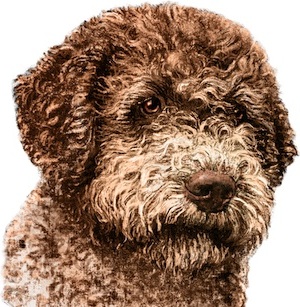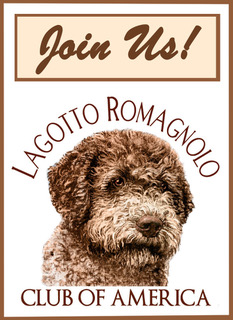|
Lagotto Romagnolo Breed Standard
General Appearance: Small to medium-sized dog, well-proportioned, powerfully built, of rustic appearance, with a dense, curly coat of wooly texture. The dog should give the impression that he has the strength and endurance to work all day in difficult and challenging terrain. Size, Substance, Proportions: Size – Height at the shoulders: Dogs 16½ to 19½ inches; Bitches 15½ to 18½ inches. Disqualification - Dog under 16½ or over 19½ inches; bitches under 15½ or over 18½ inches. Substance - Males 28 to 35 pounds. Females 24 to 31 pounds. Important Proportions - The Lagotto is a square dog, measured from the prosternum to the point of ischium and from the highest point of the shoulder to the ground. The length of the head is 40 % of the height at the shoulders. The neck is slightly shorter than the length of the head. The length of the skull should be slightly more than half the length of the head. The legs are slightly more than half the height of the dog at the shoulder. Head: Viewed from above and from the side, the head is a broad blunted wedge. The length of the skull, from stop to occiput, is the same as the width at the widest point of the zygomatic arch. The somewhat arched skull is slightly longer than half the length of the head (56 percent skull to 44 percent muzzle) with unpronounced occiput. Planes of the skull and muzzle diverge slightly - extreme divergence, parallel planes or dish faced appearance are serious faults. Nasal bone is straight. The stop is moderate, with a distinct furrow between the eyes. Frontal sinuses are well developed, giving good fill beneath the eye. Cheeks are flat. The wide robust underjaw defines the shape of the muzzle so that the lips form an upside-down semi-circle. The nose is large with wide open and mobile nostrils and a strongly pronounced median groove. It protrudes very slightly from the front edge of the lips. The nose should be fully pigmented in shades from light to dark brown, varying with coat color. Anything else is a serious fault. Lips are rather tight and not thick. The strong lower jaw determines the profile of the muzzle. The flews are tight fitting and dry. Pigment of the lips varies with coat color from light to dark brown. Well-developed teeth meet, ideally, in a scissor or level bite. A reverse scissor bite is acceptable. Full dentition is preferred. Disqualification - Overshot or undershot bites (where the incisors do not touch those of the opposing jaw). The eyes are set somewhat frontal-obliquely, and fairly well apart. They are large, rounded, fill the sockets, and very slightly protruding. The color of the iris ranges from ochre to hazel to dark brown – no other colors are acceptable. Eyelids are close fitting. Eye rim color will vary with coat color from light to dark brown. Eyelashes are very well developed. The arch of the eyebrow is prominent. The ears are medium-sized in proportion to the head, triangular with rounded tips. The base of the ear is rather wide and is set just above the zygomatic arch. When alert, the top of the ear rises to widen the appearance of the skull, and the front edge of the ear is close to the cheek. When pulled loosely forward, the ear should cover about ¼ of the length of the muzzle. The Lagotto’s expression should be intelligent, friendly and attentive. Neck Body, Topline: The neck is strong muscular, thick, and oval in shape. It is lean, well set off from the nape, and slightly arched. The length of neck is slightly less than the total length of the head. Neck should blend smoothly into shoulders. Muscles are extremely powerful. A correct neck is fundamental to function. The Lagotto body is square, compact and strong. The length of the dog, measured from the prosternum to the point of the ischium, should be the same as the height at the top of the shoulder blade, which are long and quite high-set, rising well above the level of the back. Chest is wide and well-developed, reaching down to the elbows, but not below them. The ribcage is slightly narrowed in front, widening from the sixth rib back, allowing elbows to move smoothly along the body. Ribs are well sprung (width of ribcage at the widest point is about 30 percent of the height of the dog). Underline is straight, with a slight tuck-up at the flank. The scapulae are set high, back straight, loin slightly arched, croup slightly sloping and tail follows the line of the croup. A line drawn from the top of the shoulder to the hip will be slightly sloping. A dog high in the rear or low in the shoulder is to be penalized. The Lagotto’s back is straight and very muscular. The loin is short-coupled, very strong, and slightly arched. Its width is equal to or slightly exceeds the length, giving strength for digging. Croup is slightly sloped, quite long, broad, and muscular. It forms an angle of approximately 25/30 degrees from the horizontal. Flat or steep croups are to be severely penalized. The tail is set on following the line of the croup. At rest, it is carried scimitar-like, and no higher than the back. When excited, the tail is decidedly raised, and carried in a loose arc above the level of the back. Tip of tail should not be carried further forward than the pelvis. The tail should never be curled or carried straight up. The tail tapers from base to end and should reach to just above the hock. Ringtails or tails carried over the back are serious faults. Forequarters: The shoulder blades are long (30 percent at the height of the shoulder), well laid back (yet not too close at tips), muscular, and strong. They are closely attached to the chest but move freely. The angle formed between the shoulder blade and the upper arm should be approximately 115 degrees. The elbow will fall on a vertical line lowered from the back of the scapula to the ground. The upper arm is as long as the shoulder blade, of light bone structure, muscular, and tucked firmly against the chest. Legs are straight. The forearm is long, with strong, compact, oval bone. The carpus is fine, robust and mobile, and in complete alignment with the forearm. Pasterns are also in perfect alignment with forearm, and of slightly finer bone. They are moderate in length and slightly sloping. Forefeet are webbed, rounded, and compact, with well-arched, tight toes. Pads have particularly hard soles. Nails are curved and range in color from white to extremely dark brown. Hindquarters: Angulation of the hindquarter is slightly less than the angle of the forequarter (approximately 110 degrees). Legs are powerful and parallel when seen from the rear. The upper thigh is slightly longer than the shoulder (35 percent of height at shoulders). It is quite broad, convex, and with well-defined muscles. The second thigh is slightly longer than the upper thigh, well boned and strong. The hindquarters must be perfectly parallel to the spine. The angle of the stifle should be more open than the angle at the hip, (approximately 130 degrees). The hock joint is well let down, wide, clean and strong. Pasterns are thin, cylindrical, and perpendicular to the ground when the dog is standing freely. A vertical line from the point of ischium to the ground will fall slightly in front of the toes. Hind feet are slightly oval, compact, and webbed. The toes of the back feet are not quite as arched as those of the forefeet; thus, the nails may be straighter. Skin, Coat: The skin of the Lagotto is thin, firm and close-fitting all over the body, without wrinkles. Pigmentation of the skin and pads harmonizes with the color of the coat, ranging from dark pink to dark brown. Depigmentation anywhere on the body is a serious fault. Coat is extremely important in this breed. Hair should be of wooly texture, semi-rough on the surface. Topcoat should be quite thick, and undercoat visible. The combination of the two repel water. A correct coat is never luxurious or shiny. The body is covered with tight ring-shaped curls, not frizz. Skull and cheeks are covered with thick hair, and the looser curls of the head form abundant eyebrows, whiskers, and a rather bristly beard. The coat covering the tail is both curly and somewhat bristly. The Lagotto must not be corded. Disqualification - smooth or straight coat. The correct trim must always be unpretentious, and contribute to the natural, rustic look typical of the breed. In a curled state the body coat must be trimmed to no more than 1½ inches in depth (not brushed/combed out), and it should be uniform with the silhouette of the dog. Only on the head can the coat be longer than 1½ inches, but should never cover the eyes (should be penalized). The edges of the ears should be trimmed to the leather; the surface of the ear flap should show looser curls, but remain wavy. The area around the genitals and anus may be clipped short. Hair must be of sufficient length that curls and texture can be assessed. Corded dogs or excessively groomed dogs (sculpted or blown out) should be so severely penalized as to be eliminated from competition. Color: Lagotti can be off-white solid color, white with brown or orange patches, brown roan, orange roan, brown, orange, or sable (in different shades), with or without white. Some dogs have extremities darker than their body color. Tan markings (in different shades) allowed. The colors have a tendency to fade, sometimes to such an extent that the brown areas can appear as silvery/gray roan. All the above colors are equally desirable, including the faded or diluted colors. Disqualification - Black or gray coat or patches; black pigmentation. Gait/Movement: Lagotti should exhibit an energetic, lively, balanced trot, with moderate reach and drive. Back should remain firm and strong with no tendency to roll. At a trot, the rear foot covers but does not pass the footprint of the front foot. Movement from the front is parallel at a walk or slow trot, never wider than the dog’s shoulder, and tends toward a center line as speed increases. Rear legs are also parallel at a slow gait, converging at increased speed, with hocks staying in a straight line between hip and foot. As the dog increases speed, the neck moves slightly lower and forward. The Lagotto should move with distinction and nobility of bearing. He should not be exhibited in an elongated trot – it is atypical and incorrect for the breed. Behavior, Temperament: The Lagotto is tractable, adaptable, keen, affectionate, and extremely attached to its owner. He is both highly intelligent and easily trained. He is an excellent companion and a very good watchdog. A natural gift for searching and a very good nose have made the breed very efficient in finding truffles. The former hunting instinct has been modified by genetic selection to avoid distraction by game. This breed should never be aggressive or overly shy. Faults: Any departure from the foregoing points should be considered a fault and the seriousness with which the fault should be regarded should be in exact proportion to its degree and to the degree that it will affect the dog’s ability to perform its traditional work, as well as the health and welfare of the dog. Disqualifications: Size- Dogs under 16½ inches or over 19½ inches. Bitches under 15½ inches or over 18½ inches. Bite – Overshot or pronounced undershot bite (incisors of the upper jaw and lower jaw do not touch). Coat – Smooth or straight. Color – Black or gray coat or patches; black pigmentation.
(Adopted by the Membership 23 November 2019)
|


